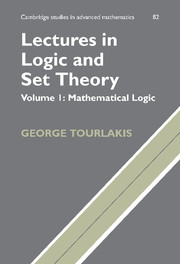II - The Second Incompleteness Theorem
Published online by Cambridge University Press: 16 January 2010
Summary
Our aim in the previous section was to present Gödel's first incompleteness theorem in the context of recursion theory. Much as this “modern” approach is valuable for showing the links between unprovability and uncomputability, it has obscured the simplicity of Gödel's ingenious idea (as it was carried out in his original paper (1931)).
What he had accomplished in that paper, through arithmetization of formulas and proofs, was to build a sentence of arithmetic, ℱ, that said “I am not a theorem”. One can easily prove, metamathematically, that such an ℱ is undecidable, if arithmetic is ω-consistent.
To see this at the intuitive level, let us replace ω-consistency by correctness. Then surely ℱ is not provable, for if it is, then it is a theorem, and hence false (contradicting correctness).
On the other hand, we have just concluded that ℱ is true! Hence, ¬ℱ is false, and therefore not provable either (by correctness).
This simple application of the “liar's paradox” is at the heart of the first incompleteness theorem.
Imagine now that the arithmetization is actually carried out within (some) formal arithmetic, and that with some effort we have managed to embed into formal arithmetic the metamathematical argument that leads to the assertion “if arithmetic is consistent, then ⊬ ℱ”. The quoted statement is formalized by “Con → ℱ”, where “Con” is some (formal) sentence that says that arithmetic is consistent.
- Type
- Chapter
- Information
- Lectures in Logic and Set Theory , pp. 205 - 318Publisher: Cambridge University PressPrint publication year: 2003



